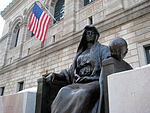Vetenskapsåret 1890
| Vetenskapsåret 1890 | |
| 1889 · 1890 · 1891 | |
| Humaniora och kultur | |
|---|---|
| Film · Konst · Litteratur · Musik · Serier · Teater | |
| Samhällsvetenskap och samhälle | |
| Ekonomi · Krig · Sport | |
| Teknik och vetenskap | |
| Vetenskap |
Händelser
Medicin
- Okänt datum - Emil von Behring och Kitasato Shibasaburō upptäcker att antitoxin för att immunisera människor mot difteri kan utvecklas genom att först testa med att injicera difteritoxin i djur.[1]
- Okänt datum - Emil von Behring och Shibasaburo Kitasato upptäcker ett serum mot difteri.
Pristagare
- Copleymedaljen: Simon Newcomb, kanadensisk-amerikansk astronom.
- Darwinmedaljen: Alfred Russel Wallace, brittisk naturforskare, geograf, biolog, antropolog och forskningsresande.
- Davymedaljen: Emil Fischer, tysk kemist, Nobelpristagare 1902.
- De Morgan-medaljen: Lord Rayleigh, brittisk fysiker.
- Rumfordmedaljen: Heinrich Hertz, tysk fysiker.
- Wollastonmedaljen: William Crawford Williamson, brittisk naturforskare. [2]
Födda
- 20 december - Jaroslav Heyrovský (död 1967), tjeckisk kemist.
- 21 december - Hermann Joseph Muller (död 1967), amerikansk genetiker, Nobelpristagare 1946.
Avlidna
- 3 februari - Christoph Hendrik Diederik Buys-Ballot (född 1817), nederländsk meteorolog och fysiker.
- 19 oktober - Émile Léonard Mathieu (född 1835), fransk matematiker.
- 26 december - Heinrich Schliemann (född 1822), tysk advokat, skattjägare och arkeolog.
Källor
Fotnoter
- ^ Waldman, Thomas A. (15 augusti 2003). ”Immunotherapy: past, present and future” (PDF). Nature Medicine "9" (3): ss. 269–277. doi:. PMID 12612576. http://www.nature.com/cgi-taf/DynaPage.taf?file=/nm/journal/v9/n3/full/nm0303-269.html&filetype=pdf.
- ^ ”Geological Society”. Arkiverad från originalet den 5 juni 2011. https://web.archive.org/web/20110605102217/http://www.geolsoc.org.uk/gsl/society/history/page750.html. Läst 13 april 2011.
Media som används på denna webbplats
(c) Boston på engelska Wikipedia & John Stephen Dwyer, CC BY-SA 3.0
Statue personifying "Science" in front of the Boston Public Library on Copley Square of the Back Bay of Boston. January 2009 photo by John Stephen Dwyer
One of the first bottles (1895) of diphtheria antitoxin produced at the Hygienic Laboratory, which became the NIH in 1930. Diphtheria antitoxin, was produced by inoculating horses or goats with increasingly concentrated doses of diphtheria bacteria. The animals were then bled and their blood serum was collected and bottled as an antitoxin. When injected into the body of a patient suffering from diphtheria, the antibodies in the horse serum neutralized the toxin causing the patient’s symptoms.



